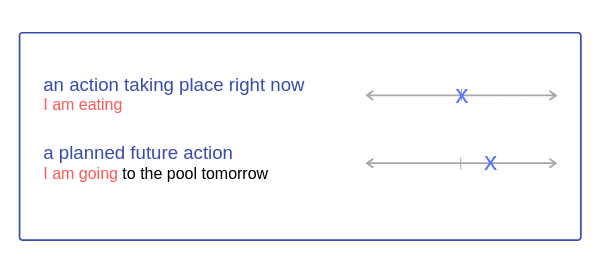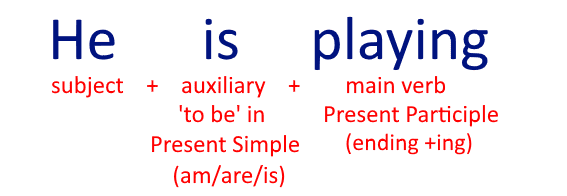Present Continuous
timeline, form, uses

The Present Continuous talks about an action or state that is happening right now. The action may be on-going into the near future. The present Continuous is also used to express already arranged future plans. Below we’ll explore the Present Continuous timeline, form, uses, with examples.
It is also called the Present Progressive or Continuous Present.
TO FORM THE PRESENT CONTINUOUS
The Present Continuous is formed using two verbs:
– auxiliary verb to be conjugated in the Present Simple tense (am / are / is)
– main verb ending +ing (present participle)

affirmative: subject + auxiliary + main verb
negative: subject + auxiliary + not + main verb
questions: auxiliary + subject + main verb
negative questions: auxiliary + subject + not + main verb
Forms of the Present Continuous for the verb to eat:
affirmative
I am eating
you am eating
he/she/it is eating
we am eating
you am eating
they am eating
negative
I am not eating
you are not eating
he/she/it is not eating
we are not eating
you am not eating
they are not eating
question
am I eating?
are you eating?
is he/she/it eating?
are we eating?
are you eating?
are they eating?
negative question
am I eating?
are you eating?
is he/she/it eating?
are we eating?
are you eating?
are they eating?
PRESENT CONTINUOUS USES
to express that something is happening right now
I am writing a letter.
Isn’t he sitting down?
to express something that is happening around now (in the near past or near future) and that is not habitual or permanent
Lucy is staying with her mother until her apartment is ready.
Isn’t she working in the London office this week?
to talk about a planned future action or event
We’re going to the Lake District next week.
Isn’t he coming to the theatre with us tonight?
expresses irritation or a negative emotion when used with words like
always, forever, constantly
which is placed between the auxiliary and main verb
She is constantly complaining about her sister.
The dogs are always bringing in mud.
to express a trend
More and more people are becoming vegan.
Everyone is getting tattoos.
CONTRACTED AUXILLIARY VERBS
The Present Continuous uses the verb to be< in the Present Simple as an auxiliary verb.
Auxiliary verbs are often contracted, especially in spoken and informal written language.
The contracted forms are:
| affirmative | contracted |
| I am | I’m |
| you are | you’re |
| he/she/it is | he’s/she’s/it’s |
| we are | we’re |
| you are | you’re |
| they are | they’re |
| negative | contracted |
| I am not / I’m not | - |
| you are not /you’re not | you aren’t |
| he/she/it is not / he’s/she’s/it’s not | he/she/it isn’t |
| we are not / we’re not | we aren’t |
| you are not / you’re not | you aren’t |
| they are not / they’re not | they aren’t |
| negative question | contracted |
| am I not? | - |
| are you not? | aren’t you? |
| is he/she/it not? | isn’t he/she/it? |
| are we not? | aren’t we? |
| are they not? | aren’t they |
More on contracted verbs
How to create the Present Participle
present continuous timeline form uses